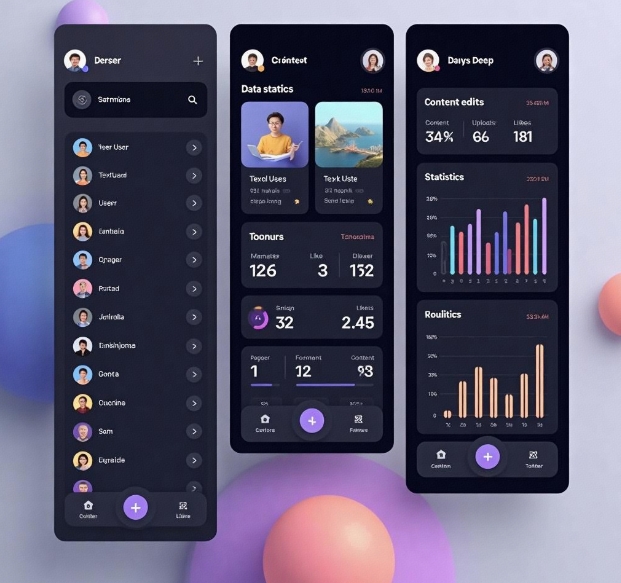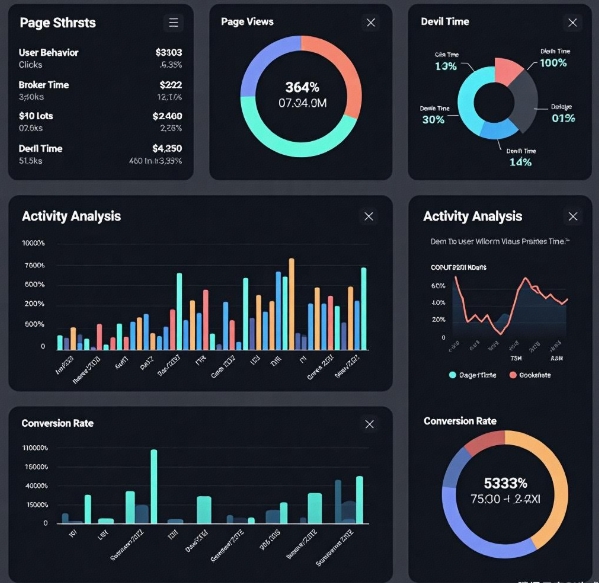Background Management and Operational Tools in Mini-Program Development
- latest articles
- 1.DApp Development & Customization: Merging Diverse Market Needs with User Experience 2.Analysis of the Core Technical System in DApp Project Development 3.How to achieve cross-chain interoperability in Web3 projects? 4.How does the tokenization of points reconstruct the e-commerce ecosystem? 5.How to Set and Track Data Metrics for a Points Mall? 6.What is DApp Development? Core Concepts and Technical Analysis 7.Inventory of commonly used Web3 development tools and usage tips 8.Development of a Distribution System Integrated with Social E-commerce 9.Six Key Steps for Businesses to Build a Points Mall System 10.What is DApp Development? A Comprehensive Guide from Concept to Implementation
- Popular Articles
- 1.Future Trends and Technology Predictions for APP Development in 2025 2.Analysis of the DeFi Ecosystem: How Developers Can Participate in Decentralized Finance Innovation 3.From Zero to One: How PI Mall Revolutionizes the Traditional E-commerce Model 4.DAPP Development | Best Practices for Professional Customization and Rapid Launch 5.Recommended by the Web3 developer community: the most noteworthy forums and resources 6.How to Develop a Successful Douyin Mini Program: Technical Architecture and Best Practices 7.From Cloud Computing to Computing Power Leasing: Building a Flexible and Scalable Computing Resource Platform 8.Shared Bike System APP: The Convenient Choice in the Era of Smart Travel 9.How to Create a Successful Dating App: From Needs Analysis to User Experience Design 10.From Design to Development: The Complete Process of Bringing an APP Idea to Life
With the rapid development of the mobile internet, mini-programs have become the choice for an increasing number of enterprises and developers. Due to their convenient usage, low development costs, and excellent user experience, mini-programs have gained widespread application. However, how to efficiently manage and operate a mini-program has become a critical issue faced by many developers and operators. During the development process of a mini-program, the design and use of backend management and operational tools are crucial for enhancing management efficiency, user experience, and data analysis capabilities.
This article will explore the core elements of mini-program development from the perspective of backend management systems and operational tools, analyze their importance, and, based on specific practices, propose how to use these tools to improve the efficiency and effectiveness of mini-program operations.
I. Overview of Mini-Program Backend Management Systems
The mini-program backend management system is the core tool for developers and operators to manage mini-programs. Through the backend management system, developers can implement various functions such as content management, data monitoring, user management, permission control, and order processing. Operators, on the other hand, can use the backend management system to analyze operational data, adjust promotion strategies, and optimize user experience.
1. Basic Functions of Mini-Program Backend Management
The mini-program backend management system includes many important functions. Here are some key components:
Content Management: The backend system can assist operators in editing and updating the content of mini-program pages, such as managing product information, activity announcements, and user feedback.
User Management: User management involves grouping users, setting tags, and managing permissions to help operators accurately push content and services. Through user profile analysis, operators can achieve precise user classification and improve the efficiency of marketing activities.
Order Management: For mini-programs with e-commerce or service functions, order management is crucial. Through the backend system, merchants can view real-time order status, handle refunds, returns, and other issues, thereby enhancing the user shopping experience.
Data Monitoring and Analysis: The backend system can monitor the operational status of the mini-program in real-time, including metrics such as traffic, user activity, and transaction data. Through data analysis, operators can promptly adjust operational strategies, identify issues, and make optimizations.
2. Technical Architecture of Mini-Program Backend Management Systems
The technical architecture of a mini-program backend management system generally includes frontend and backend components. The frontend primarily involves the design and implementation of the user interface, presented to operators via browsers or apps. The backend is responsible for data storage, processing, analysis, and other functions. Common technology stacks include:
Frontend Technologies: HTML, CSS, JavaScript, React, Vue.js, etc.
Backend Technologies: Node.js, Java, Python, etc., often using frameworks like Express, Spring Boot, etc.
Database Technologies: MySQL, MongoDB, Redis, etc., used for storing user data, order data, content information, etc.
Data Analysis Tools: For complex operational data analysis, third-party tools such as Google Analytics, Baidu Statistics, Tencent Cloud Data, etc., are often utilized.
II. Operational Tools for Mini-Programs
Operational tools for mini-programs refer to a series of tools that help businesses with daily operations and promotions. These tools assist operators in monitoring data, optimizing user experience, and conducting marketing activities. A successful mini-program relies on the support of robust operational tools. Common operational tools include the following:
1. User Analysis Tools
User analysis tools help operators gain in-depth insights into user needs and make precise decisions by collecting user behavior data. These tools can provide detailed user profiles, user behavior path analysis, retention rate analysis, etc., offering data support for optimizing mini-program content and functionality.
Common user analysis tools include:
Tencent Cloud Analysis (TCA): Provides user behavior analysis, traffic analysis, conversion rate analysis, etc., helping operators comprehensively understand user habits and product performance.
Umeng+: Allows for analysis of user activity, lifecycle analysis, channel analysis, etc., helping operators identify key points of user churn and make targeted optimizations.
Baidu Statistics: As a well-known data analysis platform in China, Baidu Statistics can provide user behavior tracking, access path analysis, and other data for mini-programs, helping businesses optimize functionality and content.
2. Promotion and Marketing Tools
Promotion is one of the keys to the success of a mini-program. Operators can use promotion tools to increase the exposure and user conversion rate of the mini-program.
Social Sharing Tools: By setting up sharing and invitation features, users are encouraged to recommend the mini-program to others, achieving viral growth. For example, mechanisms like sharing red envelopes or referral rewards can incentivize users to spread the mini-program.
Mini-Program Advertising Platforms: Platforms like Tencent and Baidu offer advertising services for mini-programs. Through ads, operators can precisely target potential users, increasing the user base.
WeChat Pay and Mini-Program Stores: For e-commerce mini-programs, the seamless integration of WeChat Pay and mini-program store functionalities greatly facilitates product display and payment processes, improving user purchase conversion rates.
3. Customer Service and Interaction Tools
A good user service experience is crucial for the long-term operation of a mini-program. Operators can use interaction tools to build closer connections with users and enhance user loyalty.
Customer Service Tools: For example, using the "Tencent Cloud Customer Service" system to provide both human and AI customer service, promptly answering user questions, handling complaints and suggestions, and improving user satisfaction.
Message Board and Feedback Tools: Setting up user feedback channels allows operators to promptly gather user needs and issues, continuously improving the mini-program's functionality and services.
Community and Group Management: Establishing close connections with users through social platforms like WeChat groups and QQ groups promotes interaction among users and increases user stickiness.
4. Operational Automation Tools
As the user base and data volume of mini-programs increase, the work of operators becomes more cumbersome. To improve efficiency, many mini-program developers are starting to use operational automation tools. These tools can help operators automate certain repetitive tasks, saving time and increasing efficiency.
Email Marketing Tools: Using email push systems to automatically send promotional information, event invitations, etc., helping mini-programs increase user revisit and conversion rates.
Scheduled Task Tools: By setting up scheduled tasks, automate notifications, regular data analysis reports, content updates, etc., to enhance operational efficiency.
A/B Testing Tools: Operators can use A/B testing tools to test different versions of pages, activity strategies, product information, etc., to identify the best operational solutions.
III. Future Development of Mini-Program Backend Management and Operational Tools
With the continuous development of technology and changes in market demand, the backend management and operational tools for mini-programs will also continue to upgrade and evolve. In the future, these tools will trend towards intelligence, personalization, and automation.
1. Intelligent Operational Tools
The introduction of AI technology will significantly improve the operational efficiency of mini-programs. For example, AI-based recommendation algorithms can accurately push personalized content and products based on user browsing history, purchase habits, social behavior, etc., thereby increasing user conversion rates.
2. Data-Driven Decision Making
With the advancement of big data technology, operators will be able to make decisions more accurately based on data analysis results. Through in-depth analysis of large volumes of user behavior data, market trends can be better predicted, operational strategies optimized, and the profitability of mini-programs enhanced.
3. Automated Marketing and Promotion
With the proliferation of marketing automation tools, operators will be able to automate various marketing activities by setting intelligent rules, such as precisely pushing coupons, sending timed notifications, etc., greatly improving the efficiency and accuracy of marketing campaigns.
IV. Conclusion
The backend management and operational tools for mini-programs are one of the core elements ensuring successful operation. Through efficient backend management systems and precise operational tools, developers and operators can effectively manage content, users, data, orders, etc., enhance user experience, optimize marketing strategies, and drive the continuous growth of mini-programs. In the future, with technological advancements, operational tools will become increasingly intelligent and automated, bringing more possibilities to mini-program operations.
-

How to Increase User Stickiness and Activity Through Mini Program Development
With the development of the internet and mobile internet, mini-programs, as an e···
-

How can mini-program development assist in corporate marketing and e-commerce transformation?
In today's rapidly evolving mobile internet landscape, corporate marketing and e···
-

Offline Functionality Design and Data Synchronization in Mini-Program Development
With the rapid development of mobile internet, mini-programs, as a lightweight a···

 Blockchain
Blockchain












